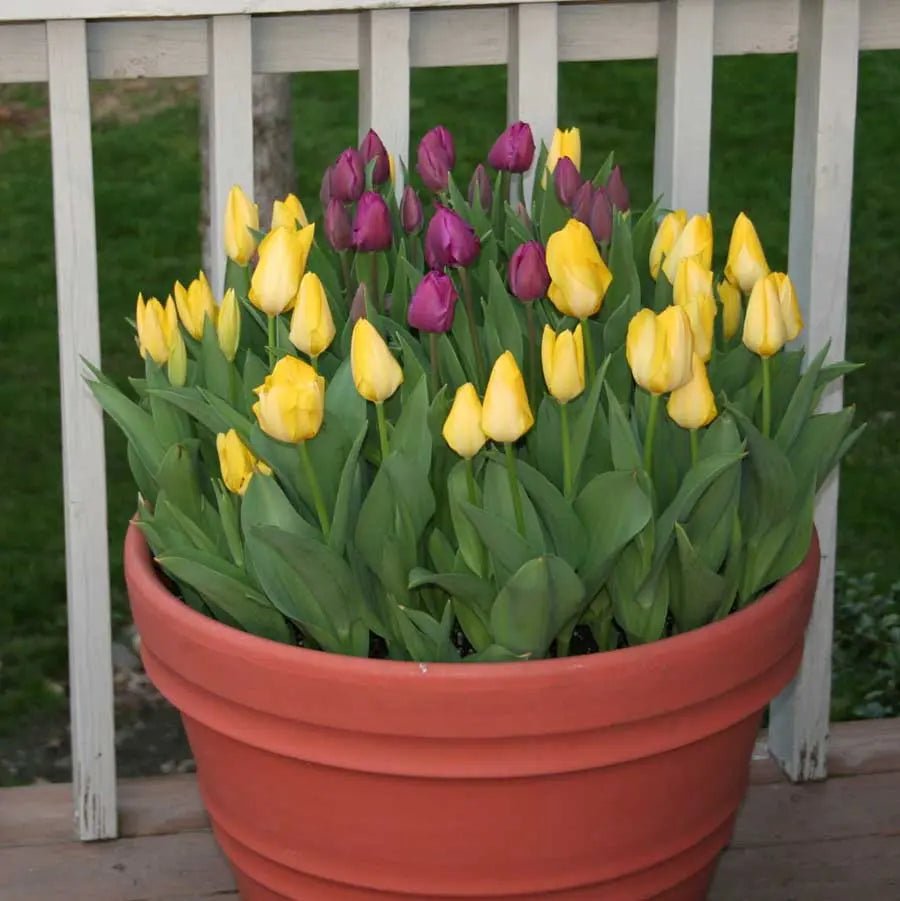
Planting and caring for tulips
Where to Plant Tulips
Tulips require full sun for the best display, which means at least 6 hours of bright, direct sunlight per day. They also prefer fast-draining soil and, consequently, make excellent additions to rock gardens.

When to Plant Tulips
Tulip bulbs should be planted in the fall. The soil needs to have cooled off from the summer growing season before you plant, which could mean September in cold climates (zones 3 to 5), October in transitional climates (zones 6 to 7), and November or December in warm climates (zones 8 to 9). Check the soil temperature with a soil thermometer and plant when the temperature is 60 degrees Fahrenheit at a depth of 6 inches.
Tulips require a chilling period in order to bloom. If you are planning to grow tulips in areas where the soil temperature does not drop below 60 degrees for at least 12 weeks, buy pre-cooled bulbs and plant them in December.
How to Prepare the Soil for Planting Tulips

Prepare the planting area for tulips with Garden Soil for Flowers, mixing 3 inches of garden soil into the top 6 to 8 inches of native soil. The nutrition provided by the soil will help tulips grow a healthy root system in the fall, which is essential for a big spring bloom. For the absolute best results from your tulips, though, you'll want to combine the power of great soil with just the right plant food—see "How to Feed Tulips" below for what and when to feed them.
How to Plant Tulips

For the biggest show, plant tulips in groups of 10 or more. Plant each bulb 8 inches deep (measure from the bottom of the bulb and include the depth of any mulch on top of the soil in your measurement), with the pointy end up. Bulbs can be planted quite closely together. Water thoroughly.
How to Grow Tulips in a Pot

Tulips are easy to grow in pots. As with in-ground plantings, you’ll want the bulbs to be buried at least 8 inches deep, so measure from the top of the container to a depth of about 9 inches, then fill the pot up to that mark with Miracle-Gro® Potting Mix. Place the bulbs pointy end up in the pot (you can pack them tightly together). Cover with the potting mix, then water well. Before your area’s first frost, move the container to a cool, dry location that stays around 40 degrees Fahrenheit during the winter. When you see tulips emerging outdoors, bring the container out into a sunny spot and water the soil. Begin watering regularly once you begin to see green growth.
How to Water Tulips
Water tulips when you plant them, giving each planting area a thorough soak. Water once per week week for the first month after planting, then leave the plants alone until springtime. Begin watering again in the springtime, when the leaves appear.
How to Feed Tulips
Once the flowers have faded, apply Miracle-like Gro® Shake ‘n Feed Rose & Bloom Plant Food, following the directions on the package. This will help promote leaf growth so the bulb can store nutrients for the next growing season. Feed for the last time each year in the late fall (around the same time as you would plant new bulbs).

How to Cut Tulips to Enjoy Indoors
Cut tulips when the buds are still tight. The petals may have a greenish tinge to them, but you should be able to tell what color the flowers are. Place in a clean vase filled with room-temperature water. Tulips will continue to “grow” (the stems elongate) once cut and brought indoors. If they become unruly, just cut a few inches off the bottom of the stems every couple of days. Cut tulips will last longer (vs. water only) if you add Miracle-Gro® for Fresh Cut Flowers to the water, and change the water every couple days.
What to Do After Tulips Bloom
In most gardens, the best tulip flower display will be the spring directly following the fall in which you plant the bulbs. To encourage species tulips to come back year after year, cut back the flower stalk to the base of the plant once the flowers fade. Feed the bulbs as described above, stop watering once the bulbs have gone dormant, and cut back foliage once it has fully turned brown. With hybrid varieties (which are not perennial), simply pull up the bulbs and compost them.
How to Protect Tulips from Deer and Other Pests
The number one challenge when growing tulips is preventing deer from eating the flowers, followed closely by keeping chipmunks and squirrels from digging up the bulbs. To prevent bulbs from being dug up, line planting holes or trenches on all sides with chicken wire. (This is most practical if you’re planting big sweeps of bulbs, which happens to be the way to get the best show with tulips.)
Deer are a different story. The best way to keep deer out of the garden is to install a tall (8 feet or more) fence, but that is not practical for most people. Deer do not eat daffodil or Crown Imperial bulbs, so interplanting tulips with these may help keep deer away. You can also try spraying bulb foliage with a deer repellent. That being said, if deer are a huge problem where you live, it’s better to grow tulips in pots on a screened-in porch where the deer can’t get to them.
How to Grow Tulips: Recap
Select a range of early-, mid-, and late-season tulips.
Plant in a sunny location with excellent drainage.
Plant bulbs in the fall for a spring bloom.
Prepare the soil by adding Miracle-Gro® Garden Soil for Flowers.
Plant tulips 8 inches deep with the pointy end up.
Water tulips thoroughly at the time of planting and again in the spring when they begin to grow.
Miracle-Gro® Shake ‘n Feed Rose & Bloom Plant Food after they flower.
Cut tulips while buds are still tight to enjoy indoors.
Keep animals at bay by lining planting holes with chicken wire, erecting a fence, spraying with repellent, or planting in pots.
Ready to start growing tulips? Click on this product links https://www.caribbeangardenseed.com/pages/search-results?q=tulips*&p=4

![[Seeds] - Caribbeangardenseed](http://caribbeangardenseed.com/cdn/shop/files/gift-card-gift-card-1_1024x1024_dfa857db-9150-4315-a362-7f0bb3fb9c47_60x28.png?v=1722895789)